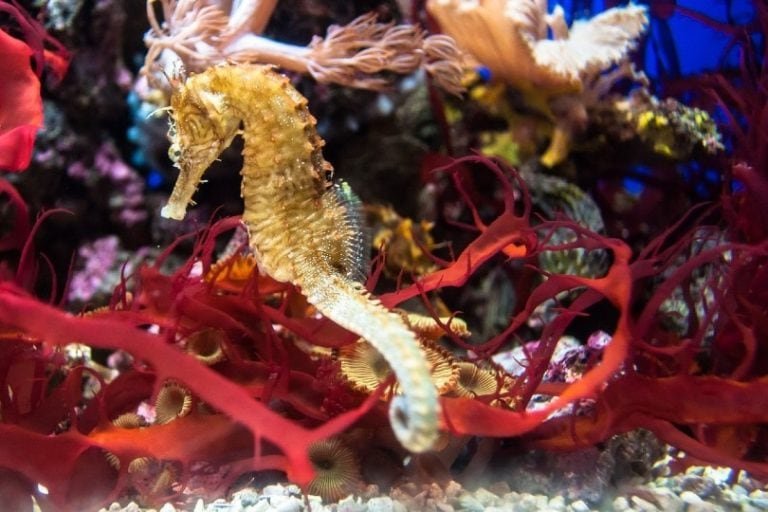
Seahorses have unique needs, and not all fish are compatible tank mates. It’s a bit like throwing a party: you wouldn’t invite people who don’t get along, right? So, let’s dive into the world of seahorse tank mate compatibility, break down what you need to know, and help you set up a harmonious aquarium.
Understanding Seahorse Behavior
To know if seahorses can live with other fish, it’s vital to understand their behavior. Seahorses are gentle and slow-moving fish. They often prefer calm waters and can get stressed in a chaotic environment. This means that choosing tank mates who also enjoy a calm lifestyle is essential.
Here’s the thing—seahorses don’t swim like most fish. Instead of darting around, they use their dorsal fins to hover and their prehensile tails to anchor onto objects like plants or corals. This unique swimming style makes them vulnerable to more aggressive or fast-swimming species that might see them as competition or, even worse, as food.
In addition, seahorses have specific dietary needs. They primarily eat small live foods like brine shrimp and copepods. So, it’s not just about getting along; it’s also about whether they can share resources in the tank without conflict.
Ideal Tank Conditions for Seahorses
Before you consider tank mates, let’s talk about what seahorses need to thrive. An ideal environment is crucial for maintaining healthy seahorse populations.
First, the water temperature should be kept between 72°F and 78°F. Seahorses are sensitive to temperature changes, so a stable environment is key. You’ll also want to ensure good water flow; however, it shouldn’t be too strong. Seahorses prefer a gentle current so they can stabilize themselves without getting tossed around.
The next important factor is tank size. Seahorses need plenty of space to roam and explore. A minimum of 30 gallons is suggested for a small group. This gives them room to maneuver and keeps their stress levels down.
Lastly, provide plenty of hiding spots and potential anchors. Plants, decorations, and live rock can create a comfortable setting, allowing seahorses to feel safe and secure.
Choosing Compatible Tank Mates
So, who can live with seahorses? The best tank mates are non-aggressive and similarly sized fish. Here are some ideas to consider:
- Pipefish: These are closely related to seahorses and often share similar needs and behaviors.
- Certain Gobies: Smaller gobies can coexist well with seahorses, provided they’re not too territorial.
- Clownfish: Generally, clownfish can be compatible, but be cautious due to their territorial nature.
- Other Peaceful Species: Look for small, slow-moving fish that won’t outcompete seahorses for food.
When picking tank mates, it’s essential to do your research. Some fish may look peaceful at first glance but can become aggressive during feeding time or in confined spaces.
Fish to Avoid with Seahorses
Now that we know who can live with seahorses, let’s discuss who definitely shouldn’t! Some fish can pose serious threats to seahorses due to their behavior or size.
Avoid these types of fish:
- Predatory Fish: Fish like angelfish and lionfish can easily see seahorses as a snack.
- Fast Swimmers: Fish that dart around quickly may stress out the slow-moving seahorses.
- Territorial Species: Fish that claim their space, like certain cichlids, can harass seahorses.
- Large Fish: Any fish significantly larger than seahorses can pose a risk, either by bullying or predation.
Avoiding these fish can help you create a peaceful tank environment for your seahorses, allowing them to flourish.
Feeding Practices in a Mixed Tank
Managing a tank with seahorses and their companions requires some attention to feeding practices. Seahorses eat small live foods, while other fish may have different dietary needs.
To keep everyone happy:
1. Choose Compatible Foods: Look for options that work for both seahorses and other fish. For example, some small flakes or pellets can work if they’re suitable for seahorses.
2. Feed Separately if Needed: If other fish are aggressive eaters, consider feeding seahorses in a separate area. This can prevent them from being outcompeted.
3. Watch for Food Competition: Keep an eye on feeding time. If you notice some fish hogging food, you might need to adjust their feeding routines to ensure everyone gets enough.
By managing feeding carefully, you can foster a peaceful atmosphere for all your tank inhabitants.
Monitoring Tank Dynamics
As you assemble your seahorse community, keep an eye on how everyone gets along. Monitoring dynamics helps catch issues before they escalate.
Pay attention to:
– Behavior Changes: If your seahorses start hiding more or seem stressed, it may signal tank mate issues.
– Feeding Habits: Are the seahorses eating well? If they’re not getting enough food due to competition, it might be time to rethink their tank mates.
– Water Quality: Regular water tests will help keep the environment stable. Remember, seahorses are sensitive to changes.
Just like any other relationship, tank mates can adapt or change their behaviors over time. Keeping a close watch helps maintain harmony in the tank.
Final Thoughts on Seahorse Compatibility
Creating a thriving aquarium with seahorses and other fish can be incredibly rewarding. It’s all about understanding their unique needs and choosing the right companions.
By selecting peaceful, compatible fish and ensuring they share a suitable environment, you can cultivate a thriving community. Just remember, patience is key. Sometimes, it takes a bit of time to find the right balance.
So, when you set up your underwater world, think about the gentle seahorse and its special place in the tank. Nurturing their environment not only benefits them but also contributes to a joyful aquatic experience for all the fish involved. Enjoy the journey of building your aquarium, and may it flourish like the vibrant ocean it reflects!

